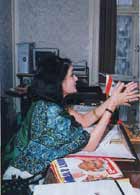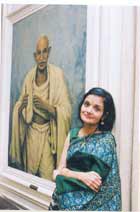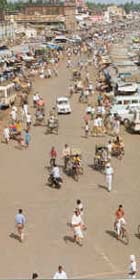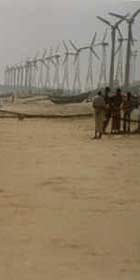Shyamala B. Cowsik
| Ambassador of India to the Netherlands |
India, the fabled land of silks, muslin and spices, was the destination of choice for seafarers, ranging from the Romans and the Arabs to Christopher Columbus and Marco Polo, right up to the 17th century. This was because it was not only an ancient and enduring civilization, but also a great economic power in the world of those times. After centuries of economic debilitation under colonial rule, the Indian economy is, once again, resurgent. Today, the IMF and the World Bank have both rated it as being the 4th largest in the world (in PPP terms), after those of the US, China and Japan, and followed by those of Germany and France.
India is not just the largest democracy in the world but, what is more important, a rock steady democracy. It has, over the 56 years since its independence, developed a large and diversified industrial sector, with an indigenous content of generally over 75%. This includes an extensive and, in many areas such as space technology, biotechnology, information technology, and renewable energy, state of the art technological establishment. This is backed up by an impressive array of industries - in petroleum, cement, fertilizers, ship building, railway equipment, machine tools, pharmaceuticals and electronics - besides the traditional sectors such as textiles, leather, gems and jewellery and agro products.
From the early 1990s, the Indian economy has surged forward, boosted by a wide-ranging and intensive economic liberalization programme, aimed at making it not only efficient but globally competitive. This programme involved the elimination of barriers to foreign trade and foreign investment, an intensive infrastructure upgrading programme, and a systematic attempt to adjust the Indian economy to the demands of globalisation. The impetus provided by economic liberalisation made it possible for India to maintain a 7% rate of GNP growth throughout the 1990s, even while managing to escape the economic meltdown that afflicted and, to a large extent continues to afflict East Asia and South East Asia. With foreign exchange reserves of over US$ 80 billion, up from barely US$ 1.2 billion in 1990, foodgrain reserves of nearly 30 million tonnes and a sustained if modest foodgrains export programme, a striking growth in exports of nearly 20% despite the global trade slump and an appreciating Indian rupee, and generally favourable financial indicators, the Indian economy seems well poised to ride out the current worldwide economic slowdown that verges on depression. In this process, India looks forward to strengthening and expanding its ties with the Netherlands, both in the trade and investment sectors as also that of technical cooperation.
India and the Netherlands, once separated both by geography and by history - the Dutch colonial contacts with India were fitful and relatively brief, which was perhaps all for the best - have in recent times come much closer, and this as much through trade and technical cooperation as through shared political values. Both are sturdy, self-reliant and self-assured democracies, and the absence of bilateral political problems has made the increasing focus on commercial ties, both bilateral and multilateral, that much easier. Throughout last year, and into the beginning of 2003, they commemorated four centuries of this late flowering bilateral relationship. The future that both countries will share holds much potential and great promise.
The earliest Indo-Dutch contacts - from the 1597 voyage of two Dutch ships to India and the establishment of a few Dutch trading posts, to 17th century Dutch scholars like Herbert de Jager studying Sanskrit, Tamil and Telugu, and Johan Joshua Ketelaar compiling the first Hindustani grammar in Dutch were sparse. However, the Dutch giant Philips has been in India since just after World War 1, and by the 1970s, was fond of claiming that it reached places in India that even the Indian Railways did not touch. Indians hardly remember that Hindustan Lever is an offshoot of the Dutch giant Unilever. ABN AMRO is a successor of the Netherlands Trading Company, established in Kolkata since 1927.
Royal Dutch Shell has long been a major presence in India, and its plan to invest US$ 1.156 billion in port development and gas-based industries in Gujarat is a vote of confidence in the Indian economy. It has also recently secured approval for opening 2000 retail outlets for petroleum products across India. Shell will bottle and market liquefied petroleum gas. Shell Solar India is marketing solar lighting systems. Shell is now also planning to enter the chemicals sector as well, beginning with a bitumen plant to cater to the zooming demand of the gigantic 5846 kms Golden Quadrilateral highway project linking Delhi-Mumbai-Chennai-Kolkata-Delhi, to be completed by December 2004, and the even larger 7300 kms North-South and East-West highway project, targeted for completion in December 2007.
Philips, a household name in India for consumer electronics, is now moving to use India as an export hub. Philips CEO Gerard Kleisterlee, after a tour of India in September 2003, announced a doubling of its current investment in its Bangalore software development centre over the next 2-3 years. Philips will position India as a global base for its software development and knowledge intensive work. It will also be moving part of its medical systems business to India. Philips Medical Systems already operates in ultrasound, cardio-vascular, MRI and other patient monitoring systems.
Among the biggest Dutch success stories in India are the big three of Dutch banking – ABN AMRO, ING and Rabobank. ABN AMRO, which has won the prestigious Indian forex clearing mandate, already has 12 branches in India and, benefiting from India's surging hi-tech IT sector, is using India as a platform for expanding its global transaction services business, besides targeting 2 million Indian customers over the next 2-3 years. ING is doing likewise, and is steadily expanding its stake in both direct banking and the life insurance business. The third of the big three of Dutch banking, Rabobank, is expanding into agro-financing and undertaking carbon credit purchases from Indian renewable energy projects on behalf of the Dutch government. All three have benefited to the full from the sustained economic liberalisation programme of the Government of India over the last 12 years, as have the other Dutch majors in India.
KLM has not only expanded its air services to and from India tremendously but is also looking for airport upgrading contracts, DHV has a consultancy stake in the mammoth, 5840 kms Golden Quadrilateral road upgrading project. IHC Holland has been deeply involved in the dredging sector in India for over 50 years. Then there are also Akzo Nobel, Gist Brocades and many others, besides a steadily growing number of small and medium Dutch firms that perceive India both as a huge market and as a technical and professional resource base with which they can do business with full confidence.
It is no wonder that when the then Dutch Minister for Foreign Trade, Mr. Gerrit Ybema, went to India in January 2002, he was accompanied by the largest business delegation he had ever led, and the visit was very successful A similar visit, at the end of November 2002 of a trade delegation jointly led by the Dutch Ministers of Foreign Trade and of Development Cooperation was equally productive. In between, the then Indian Minister for Commerce & Industry, Mr. Murasoli Maran, led a high-powered Indian business delegation to the Netherlands for a successful Destination India trade and investment promotion event in February 2002.










